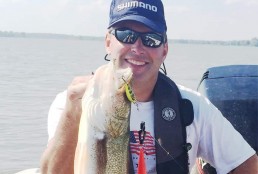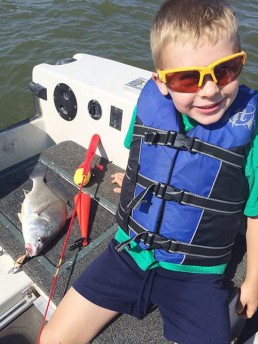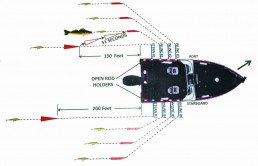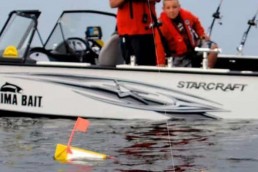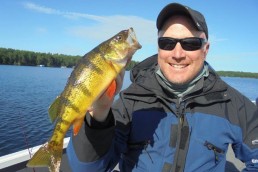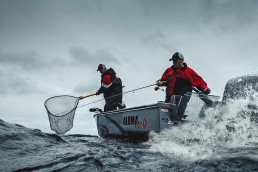Stern ‘Planing’: A Creative New Twist on Trolling
SHARE THIS POST
a MidWest Outdoors exclusive
The pressure was on to catch fish. I was fishing with people with high expectations. They had heard stories of me recently catching large numbers of fish, and they wanted in on the action. On the crew were my brother-in-law, Jim Boots, who loves to fish, and Gary Ebben, who was looking to learn more about fishing.
It was mid-April, and the walleyes had just finished spawning and were feeding as they headed out to the Bay of Green Bay. We were fishing a specific contour depth on a Green Bay-area river tributary, and it was important that we used Church Tackle Stern Planers, which are designed to stay directly behind the boat.
As I followed the contour with planers 150 and 200 feet straight behind, I had confidence with the exact dive depth of the crankbait versus the total water depth on my sonar. For the inline boards running out to the sides of the boat and with the sloping contour, I could only guess how deep to run the lure because the exact water depth away from the boat was unknown. I was sure the inline planer boards had some shallow-side lures digging up the bottom and were getting fouled, while lures on the deep side were running too high in the water column to catch walleyes near the bottom because of the river current.
As expected, the Stern planers caught their share of fish. Every 30 minutes, after coming to the end of the mile-long trolling pass, I turned the boat around and fished the contour heading the other direction. The lures on the planers were still at the right depth, so they never came in unless they had a fish. Whenever we turned around and headed back where we came from, all lures on inline planer boards had to be reset for different depths because they switched from being on the deep or shallow side. We ended up having a very successful outing with Gary as he got his first walleye and several of them in the 24- to 28-inch range.
Fishing with kids
I am fortunate to be able to take young kids fishing because they rekindle the excitement in fishing. Nothing makes them, or myself, smile more than when they can reel in their own fish. Stern planers create such little water resistance that kids can fight fish in the entire way by themselves. When fish are caught on regular inline planer boards there is resistance that pulls hard to the side and feels heavy—kids will usually hand me the rod after reeling the fish in halfway because of this and they are tired out. This reduces excitement for them because they couldn’t do it all on their own and sometimes don’t consider the fish theirs.
Stern-planer tactics
In Wisconsin, three lines are allowed per angler, so when fishing with three people I normally troll with eight lines (three inlines on the starboard side, three on the port and two stern planers). I like to run the Stern planers straight behind the boat set at 150 and 200 feet back after attaching the planer. If the port and starboard planers are staggered 50 feet, they rarely tangle, even when making aggressive turns.
I prefer to run these planers in the rod holders farthest back in the boat in either a horizontal or vertical position. When the rods are in the horizontal position, the planer will follow the exact route the boat took because the fishing line is 100 percent in the water and creates line drag. If you have the rod in the vertical position, the line is out of the water and these planers will cut the corner when you make a turn because the line is lifted off the water and isn’t creating as much drag.
Another advantage of having them far back in the boat is that they don’t interfere with your inline boards. For example, if I catch a fish on a starboard-side inline planer board, I place the starboard Stern planer’s trolling rod vertically into a spare rod holder for the port side. The starboard inline board with the fish on it can now be retrieved in. Once the fish is in the boat, I place the starboard planer trolling rod horizontally back into the rod holder.
Here’s a trick that will help you catch a few extra fish: When you get a strike on an inline planer board, wouldn’t it be nice to run another lure right through the same area without turning around?
Are you enjoying this post?
You can be among the first to get the latest info on where to go, what to use and how to use it!
It can be done, using the “inside” Stern planer.
For example, when there is a bite on the planer board on the port side, as the person is reeling in the fish turn the boat hard to port. Instead of moving the port-side stern planer’s rod to starboard, take it out of the rod holder, lift it up and over the person fighting the fish and place the rod vertically back into the port-side rod holder. If the planer is 150 to 200 feet back, it will now pass through close to where the fish was caught on the inline planer board lure. I call this the “Stern Planer Dance,” and it has often resulted in doubling-up on fish (see figure 1).
As a point of reference, if you’re trolling at 2 mph and the stern planer is 150 feet behind the inline planer, theoretically, there are 51 seconds to move the boat over the distance between the inline board’s original path and the position from which the Stern planer was running. Realistically, there are probably only about 30 seconds, because it takes time to react and see that you have a fish on the planer board. Still, you have plenty of time to do the “dance.”
Refining techniques
So what’s next with the Stern planer?
I’m currently experimenting with placing steel shot in the smaller version (there are two sizes: the larger 007 weighs 3 ounces, the smaller 005 weighs 1 1/2 ounces). I want to see if the rattling noise appears to attract or repel fish. We all know that lures with rattles can sometimes outperform lures without rattles. I’m placing a size 10 number 1 steel shot through the rubber-plugged hole in the back of the 007. The theory is the steel shot will move back and forth in the planer as it passes over the waves. By demonstrating this action with the planer in the boat, it’s loud and sort of sounds like a baby’s rattle. I have had a few times when the “rattling” Stern planer outproduced one without shot in it.
Rattling Stern planers seem to produce best when there are approximately 1-foot waves, which create a gentler rattling noise. It is important to note that I haven’t yet seen a situation where it was obvious that the silent Stern planer outproduced the one with rattles. To truly test this, you need to run the same lures on both Stern planers at the same depth.
I will continue to experiment more with this in 2016 and gather more data and report on my findings in MidWest Outdoors.
Steve Becker is part of Mark Martin’s pro staff. He resides in De Pere, Wis. and is an avid walleye fisherman who fishes almost exclusively in Green Bay and its tributaries. Becker can be reached at skbecker6@yahoo.com.
MWO
SHARE THIS POST
Did you enjoy this post?
You can be among the first to get the latest info on where to go, what to use and how to use it!
Mark Martin
Mark Martin is a professional walleye tournament angler and instructor with the Ice Fishing School/Vacation series. For more information, check out his website at markmartins.net or fishingvacationschool.com.
